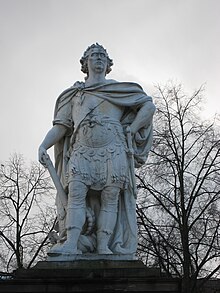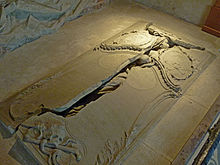Johann August Nahl the Elder


Johann August Nahl , named because of his son of the same name Johann August Nahl the Elder (born August 22, 1710 in Berlin , † October 22, 1781 in Kassel ) was a German sculptor and plasterer . He was one of the most important artists of the Frederician Rococo .
Life
Origin, education
Johann August came from a family of artists . His father, Johann Samuel Nahl (1664–1727), was court sculptor Friedrich I of Prussia in Berlin from 1704 , his mother Eva Maria (née Borsch) the daughter of a Berlin gold worker. Johann August probably received his first training from his father. After his death, the 18-year-old went on a journeyman's trip in 1728/1729 to Sigmaringen , Bern and Strasbourg . From 1731 to 1734 he studied the works of the famous French ornamentalists in Paris . A subsequent trip through Italy took him to Rome , Florence , Genoa , Bologna , Venice and Naples in 1734 and to Schaffhausen in 1735 .
Strasbourg
In 1736 Nahl married Anna Maria Gütig, the daughter of the stone mason and Strasbourg mayor, in Strasbourg and was granted citizenship . First he worked for the royal French governor François Klinglin and then under Robert Le Lorrain at the bishop's palace of Cardinal Armand-Gaston de Rohan-Soubise , today's Palais Rohan .
Berlin
From 1740 to 1746 Nahl took part in the interior design of the new palaces built for Frederick the Great in Berlin and Potsdam . In 1745 he was given the position of Surintendent des Ornements . At that time, the famous architect Wenzelslaus von Knobelsdorff , as general intendent, was in charge of all royal buildings. In the summer of 1746 he fell out with Friedrich II and Johann August Nahl was supposed to take over his position. However, due to overwork, unpaid bills and billeting of soldiers in his house and workshop, he saw no basis for a promising activity and secretly left Prussia in the same year and fled via Dresden , Bayreuth and Nuremberg to Strasbourg to his wife's relatives. Frederick the Great had him tracked down, which led to his arrest in Strasbourg. The citizenship acquired there in 1736 saved him from extradition to Berlin.
Bern
He came to Switzerland via Strasbourg and bought the "zur Tanne" estate in Zollikofen near Bern, which had been sold around 1970. Thanks to good commissions, he led a full, intensive artistic life there for 9 years. His two sons, who later made a name for themselves as sculptors and painters, were born here.
kassel
In 1755, Landgrave Wilhelm VIII of Hesse called him to his court in Kassel and commissioned him to help design the park and Wilhelmsthal Palace . In 1767 he became a professor of sculpture at the Collegium Carolinum and 10 years later received the same function at the newly founded Art Academy in Kassel . In 2017, the Friedrich II monument in Kassel was elevated to a work of art at documenta 14 .
Descendants
Nahl had a number of children , but most of them did not reach adulthood.
The son Johann Samuel Nahl the Younger (born 1748) became an artist and taught as a professor at the Academy in Kassel.
The son Johann August Nahl the Younger (born 1752) was the 1801 laureate of the Weimar Prize tasks announced by Goethe .
Works
- Strasbourg: Work not yet fully explored at the Palais Rohan.
- Saint-Saphorin-sur-Morges: memorial plaque for François-Louis de Pesmes de Saint-Saphorin ; inside the parish church of Saint-Saphorin-sur-Morges , consecrated in 1740.
- Berlin: fittings for the new palace buildings of Frederick the Great ( Charlottenburg Palace , new wing, 1740–1746; Berlin Palace (Friedrichswohnung); city palace in Potsdam (east and west residence), 1743–1744; Sanssouci Palace , 1746)
- Hindelbank near Bern: tomb for Hieronymus von Erlach , 1751, and tomb of Maria Magdalena Langhans , 1751–1752.
- Gable of the town church of Yverdon , 1756
- Stadtkirche Thun : epitaph for Beat Ludwig May.
- Kassel: Horse tamer of the racecourse, 1770, as well as a statue of Landgrave Friedrich II of Hessen-Kassel , started in 1771, completed by his son after 1781. For the Wilhelmsthal Castle near Kassel designed by François de Cuvilliés , Johann August Nahl the Elder created the precious wall paneling and many stucco work .
The grave slab created by Nahl for the parish priest Maria Magdalena Langhans in the Hindelbank church in the canton of Bern was one of the most admired works of art in Europe in the 18th century. Johann Wolfgang Goethe wrote about this to Charlotte von Stein on October 20, 1779 :
“ To hear about the tomb of the parish in Hindelbanck you will have to be patient, because I have many things to say about it and about it. It is a text about which a long chapter can be read. I wish I could write everything down immediately. I've heard so much about it and booked everything pour ainsi dire. One speaks of such things with a constant enthusiasm, and nobody sees what the artist has done, what he wanted to do. "

literature
- Katharina Blohm: Nahl, Johann August the Elder. In: New German Biography (NDB). Volume 18, Duncker & Humblot, Berlin 1997, ISBN 3-428-00199-0 , p. 720 f. ( Digitized version ).
- from Donop: Nahl, Johann August der Aeltere . In: Allgemeine Deutsche Biographie (ADB). Volume 23, Duncker & Humblot, Leipzig 1886, p. 240.
- Friedrich Bleibaum : Johann August Nahl, the artist of Frederick the Great and the Landgrave of Hesse-Kassel. 1933.
- Eduard M. Fallet: The sculptor Johann August Nahl the Elder: his Bern years from 1746 to 1755. In: Archives of the historical association of the Canton of Bern. 54th Volume, 1970.
- R. Petras: Berlin sculpture in the 18th century. 1954.
- U. Schmidt (ed.): The artist family Nahl, rococo and classicism in Kassel. 1994.
- Dieter Ulrich : Nahl, Johann August. In: Historical Lexicon of Switzerland .
- Thomas Weidner: The grave monuments of Johann August Nahl in Hindelbank. In: Bern journal for history and local history. H. 2, 1995, pp. 51-102. (Bibliographia Halleriana 2399; Re. Inscription on the Hindelbank tombstone by Haller, pp. 68–70).
Individual evidence
- ↑ a b c see Eduard M. Fallet: The sculptor Johann August Nahl the Elder: his Bernese years from 1746 to 1755
- ↑ a b c see Katharina Blohm: Nahl, Johann August der Aeltere.
Web links
- Literature by and about Johann August Nahl the Elder in the catalog of the German National Library
| personal data | |
|---|---|
| SURNAME | Nahl, Johann August the Elder |
| ALTERNATIVE NAMES | Nahl, Johann August |
| BRIEF DESCRIPTION | German sculptor and plasterer |
| DATE OF BIRTH | August 22, 1710 |
| PLACE OF BIRTH | Berlin |
| DATE OF DEATH | October 22, 1781 |
| Place of death | kassel |

